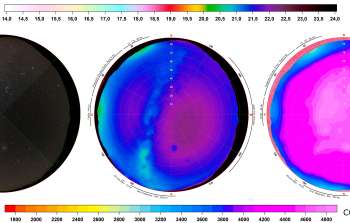sci24029 — Announcement
Light Pollution Measurements of Chilean Night Sky
May 9, 2024
Light pollution is today acknowledged as a global issue that, similar to other forms of anthropogenic pollution, has significant impacts on ecosystems and wildlife, and adverse effects on living organisms. Originally discussed by the professional astronomical community, which was concerned that the inefficient, unnecessary, and uncontrolled use of artificial light at night (hereafter ALAN) could hamper observations at professional observatories, nowadays ALAN has become a fertile field for interdisciplinary scientific research, socio-economic studies, and wide-ranging cultural debates.
Plentiful evidence suggests that ALAN has been increasing at an unprecedented rate on all scales. Even remote areas with a reputation for unspoiled nature and pristine skies are today not immune from the rapidly evolving effects of light pollution. Chile, which, thanks to its unique environmental conditions, has become one of the most prominent astronomical hubs of the world, is no exception.
In the recent paper Toward a Spectrophotometric Characterization of the Chilean Night Sky. A First Quantitative Assessment of ALAN across the Coquimbo Region, the team presents the first results of a long monitoring campaign aimed at quantifying the effects of ALAN on the brightness and colors of the Chilean sky. Through the analysis of photometrically calibrated all-sky images captured at four representative sites with an increasing degree of human activity, and comparison with state-of-the-art numerical models (see graphic), the researchers demonstrated that significant levels of light pollution have already altered the appearance of the natural sky even in remote areas.
During the site selection process we chose four representative locations that could effectively span the wide range of average night sky conditions expected across northern Chile. In increasing levels of human influence, they are: (i) Fray Jorge National Park (FJNP), a UNESCO Biosphere Reserve and the first certified Starlight Reserve in South America; (ii) Las Campanas Observatory (LCO), a professional astronomical observatory situated on the administrative border between the Atacama and Coquimbo Regions; (iii) Collowara Astrotourism Observatory (CAO), an educational and cultural center located close to the mining city of Andacollo; and (iv) Greater La Serena (LS-CQ), which, with a population of 448,784 inhabitants at the 2017 national census, is the fourth-largest metropolitan area in Chile.
For example, the observations have revealed that the light pollution level recorded in Andacollo, a small mining town of the Coquimbo Region, is comparable with that of Flagstaff, Arizona, a Dark Sky City that is ten times bigger; and that La Serena, a mid-size urban area that is a gateway to the Atacama Desert, displays photometric indicators of night sky quality that are typical of the most densely populated regions of Europe.
These results suggest that there is still much to be done in Chile to keep light pollution under control. The scientific evidence presented in this paper has also already offered valuable support to public committees at the municipal, regional, and national levels, and has empowered them to formulate data-driven strategies to protect the darkness of the Chilean sky, a natural and cultural heritage that it is our scientific, social, and moral responsibility to defend and preserve for all future generations.
The paper was also highlighted in the American Astronomical Society Research Highlights.
About the Announcement
| Id: |
ID
sci24029
|
